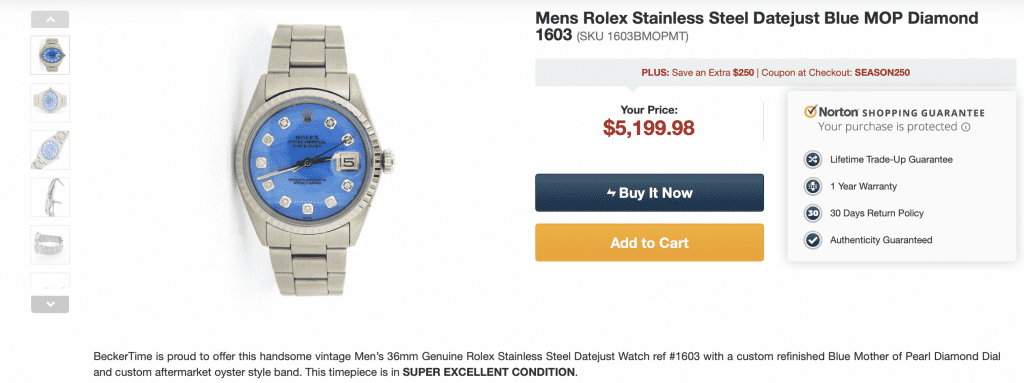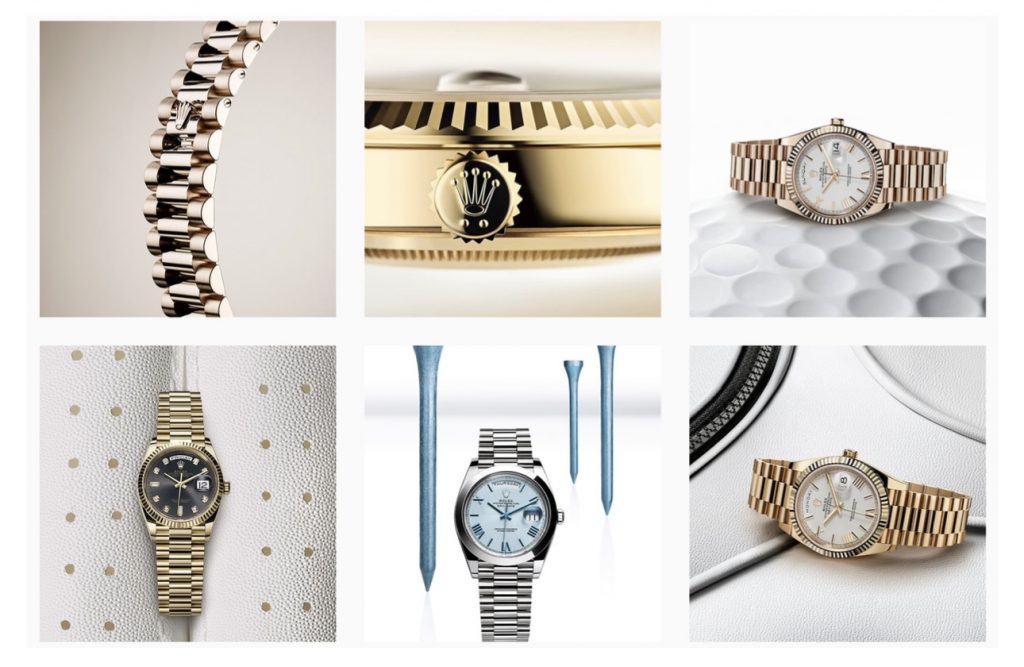Rolex has succeeded in putting a stop to an unaffiliated company’s sale of “refurbished” watches bearing its famed trademarks. After filing a trademark infringement and counterfeiting lawsuit against BeckerTime and its co-owner and officer Matthew Becker (the “defendants”) back in 2020, alleging that the Texas-based watch-seller was running afoul of the law by way of its “advertising, promotion, service, and sale of watches and watch parts that are not authorized or sponsored by Rolex and that are not genuine [Rolex] products,” Rolex has prevailed in its bid to block the company from offering up modified watches that “contain both Rolex and non-Rolex parts,” while marketing itself as a “Rolex certified watchmaker.”
At the heart of Rolex’s case are its claims that BeckerTime engaged in trademark infringement and counterfeiting by using Rolex trademarks in connection with formerly authentic but modified Rolex watches by adding “aftermarket bezels” and “aftermarket bands or straps … that sometimes include a genuine Rolex clasp or buckle displaying Rolex’s trademarks” – none of which are “made or endorsed by Rolex.” By replacing these “integral and necessary” parts with non-genuine Rolex replacement parts that are “inferior in quality,” and at the same time, holding itself out as a “Certified Pre-Owned Watch Dealer” and “Rolex Certified Master Watchmaker,” Rolex alleged that BeckerTime was likely to confuse consumers as to the nature of – and Rolex’s affiliation with – the watches.
In a memorandum and order dated January 31, which comes on the heels of an October bench trial, Judge Reed O’Connor of the U.S. District Court for the Northern District of Texas sided in large part with Rolex, finding that by making unauthorized use of Rolex marks on goods covered by federal trademark registrations, BeckerTime and its owner are on the hook for trademark infringement and counterfeiting.
Considering the various likelihood of confusion factors (i.e., similarity of the marks, the defendants’ intent, evidence of actual confusion, etc.), Judge O’Connor found that they weigh in favor of a finding of infringement. Among other things, the court found that “there is some level of actual confusion exhibited by BeckerTime’s customers regarding the authenticity of [its] watches,” as consumers expressed confusion as to whether the watches were “fully genuine Rolex” and complained about “the quality of the watches” and that they were “not actually composed of exclusively genuine Rolex parts,” which “shows some actual confusion.” Beyond that, the court held that BeckerTime’s pattern of touting itself as a “Rolex certified watchmaker” is “confusing and suggests an affiliation or sponsorship.”

While BeckerTime utilized disclosures in connection with the product descriptions on its website and eBay listings, which indicated that “the replacement parts are not genuine Rolex parts, that BeckerTime is not affiliated with Rolex, and that the alterations will void the Rolex warranty,” the disclosures did not serve to “fully alleviate confusion.” The court pointed out that BeckerTime’s use of the words “GENUINE ROLEX” was “more prominent than any disclosures.”
Still yet, the court held that BeckerTime’s “placement of original Rolex clasps” – which are traditionally adorned with Rolex’s crown logo – “on non-genuine bracelets increased the likelihood of confusion as to the genuineness of the watch,” and in fact, meets the higher bar of trademark counterfeiting.
Fair Use & First Sale
Turning to defenses that the defendants set out in response to Rolex’s trademark claims, the court determined that they are not shielded from liability. In terms of the defendants’ fair use argument, the court stated that BeckerTime was “not using the Rolex trademarks to identify Rolex’s products.” Instead, BeckerTime used the Rolex trademarks to “identify its own altered watches,” thereby, removing the potential applicability of a nominative fair use defense, which allows for the use of another’s mark truthfully to identify goods or services.
As for their First Sale Doctrine defense, the defendants were similarly unsuccessful because the modified watches are “materially different than the original Rolex watches,” thus, invoking one of the key exceptions to the trademark tenet that states that a trademark holder’s rights under the Lanham Act are exhausted after the trademark holder releases the goods into the market. Shooting down the defense, the court held that in altering the watches, BeckerTime “does more than stock, display and resell Rolex watches.”
Not a total loss for the defendants, the court did side with them on the affirmative defense of laches, determining that the Swiss watch giant waited too long to file suit given that it should have known about BeckerTime’s practice of offering up counterfeit or otherwise infringing watches back in 2010 when its outside counsel became aware of “shipments to BeckerTime of used Rolex watches,” and the allegedly subpar quality of the watches.
“Rolex offers no valid justification” for its delay in taking action against BeckerTime, per Judge O’Connor, who held that “BeckerTime likely would not have shifted its business model to be reliant on the sale of modified Rolex watches if Rolex had brought this lawsuit promptly.” As such, the court concluded that BeckerTime “relied on Rolex’s cooperation in building this valuable business,” making it so that Rolex “may not disgorge BeckerTime of [previously-earned] profits, even though, BeckerTime is enjoined from further infringing activities.”
Not a closed case yet, the court has ordered Rolex to provide proposed injunctive language no later than February 9, at which point BeckerTime shall have the opportunity to respond to (and presumably, push back against) Rolex’s proposal.
A Few Takeaways
Unsurprisingly, the role of the robust secondary market for luxury watches – which has surged even more during the pandemic and in light of supply chain woes over the past year, in particular – appeared to play a role in the outcome. In its recent memo and order, the court stated that consumers were likely to be confused in a post-sale capacity, noting that “there is a strong secondary market for used Rolex watches” as a result of the quality and longevity of its watches. (And likely helped along by the “hundreds of millions of dollars” that Rolex has spent on advertising in the United States in the past five years, alone.)
The court stated that BeckerTime provided inquiring consumers with “further descriptions [about its modified watches] and reiterate[d] that Rolex will no longer service the watches in question,” as once a Rolex watch has been altered with parts that are not Rolex parts, the company “will not guarantee the quality, performance, or function of the watch,” and has been clear that altering a watch with nongenuine parts voids the Rolex warranty for the watch. However, the court also confirmed that “subsequent potential purchasers of BeckerTime’s watches” – i.e., resale purchasers – “may not have the benefit viewing BeckerTime’s product listings and disclaimers.”
Rolex previously argued in the case that regardless of the sufficiency of the point-of-sale disclosures, “downstream purchasers of BeckerTime’s altered Watches” would likely be “completely unaware of BeckerTime’s disclaimers.”
The case is the latest in a running string of watch modification matters that have arisen over the years, at least some of which – such as the Rolex v. La Californienne case – have centered on Rolex timepieces. Not limited to suits initiated by Rolex, these cases also include Hamilton International v. Vortic Watch, which BeckerTime cited in an earlier stage of the litigation, in which the U.S. Court of Appeals for the Second Circuit determined last year that Vortic Watch’s use of antique Hamilton pocketwatch parts in its wristwatches does not amount to trademark infringement, given that Vortic had fully disclosed that its watches were made from refurbished antiques and were not associated with Hamilton, thereby, removing the likelihood that consumers would be confused.
The case is Rolex Watch USA, Inc., v. BeckerTime LLC, et al., 4:20-cv-01060 (N.D. Tex).














